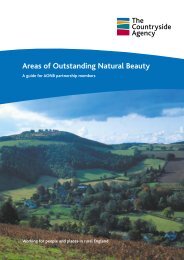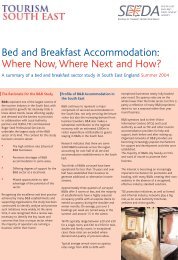The Historic Environment: A Force for Our Future - TourismInsights
The Historic Environment: A Force for Our Future - TourismInsights
The Historic Environment: A Force for Our Future - TourismInsights
You also want an ePaper? Increase the reach of your titles
YUMPU automatically turns print PDFs into web optimized ePapers that Google loves.
8 <strong>The</strong> <strong>Historic</strong> <strong>Environment</strong>: A <strong>Force</strong> <strong>for</strong> <strong>Our</strong> <strong>Future</strong><br />
<strong>The</strong> <strong>Historic</strong> <strong>Environment</strong> – A New Vision<br />
4 <strong>The</strong> importance we attach to our past shows<br />
itself in many different ways. <strong>The</strong> popularity of<br />
television programmes such as Channel 4’s Time<br />
Team and the BBC’s History 2000 season is one<br />
indicator. <strong>The</strong> number of visits made to historic<br />
properties is another. In 1999-2000 English<br />
Heritage welcomed nearly 12 million visitors to<br />
its sites. No other heritage organisation in<br />
England can match the National Trust’s<br />
membership of 2.7 million. Each year more and<br />
more people take advantage of Heritage Open<br />
Days to see <strong>for</strong> themselves, free of charge, a vast<br />
range of buildings around the country that are<br />
normally closed to the public or charge an<br />
admission fee. In 1999 more than a million visits<br />
were made to the 2,400 participating properties.<br />
5 <strong>The</strong> diversity of ways in which people<br />
experience or relate to our historic environment is<br />
one of its strengths. For some it is a medium <strong>for</strong><br />
learning about the past; <strong>for</strong> others a visitor<br />
experience; <strong>for</strong> many it provides employment; <strong>for</strong><br />
still more it provides a home or place of work; <strong>for</strong><br />
everyone it is a contributor to overall quality of<br />
life. This diversity is reflected in the complexity<br />
of interests involved: individuals; communities;<br />
visitors; owners; the voluntary sector; business;<br />
central and local government.<br />
6 <strong>The</strong> interplay between these different interests<br />
creates a dynamism which has produced some<br />
exciting developments in recent years. Consider,<br />
<strong>for</strong> example, the massive strides taken to increase<br />
people’s access to the historic environment, both<br />
physically and by way of electronic media. Ten<br />
years ago the concept of using a website, such as<br />
English Heritage’s, to help with a school project<br />
on Hadrian’s Wall would have been unimaginable.<br />
And the needs of people with disabilities are<br />
increasingly catered <strong>for</strong> at many sites across the<br />
country. Linked with this increased emphasis on<br />
accessibility, great strides have been made in<br />
realising the educational potential of historic sites,<br />
particularly <strong>for</strong> school-age children, and in<br />
developing a more inclusive approach to their<br />
presentation and interpretation. Substantial<br />
progress has also been made in recognising and<br />
harnessing the contribution that historic<br />
buildings can make to economic and community<br />
regeneration. English Heritage’s Heritage<br />
Economic Regeneration Scheme and the Heritage<br />
Lottery Fund’s Townscape Heritage Initiative<br />
have both acted as important catalysts <strong>for</strong><br />
community-led renewal and as a spur to wider<br />
investment, both public and private.<br />
7 Another important development has been the<br />
gradual widening of the definition of what people<br />
regard as their heritage and the way in which the<br />
national organisations have responded to this. <strong>The</strong><br />
National Trust’s purchase of Paul McCartney‘s<br />
childhood home in Liverpool was perhaps the<br />
most high-profile signal of this responsiveness,<br />
but the investment in urban parks and gardens<br />
and the preservation of back-to-back housing in<br />
Birmingham and Manchester are also significant.
















